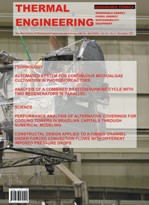| Vol.
16 - No. 2 December 2017 ISSN 1676-1790 |

| AOS AUTORES FOR AUTHORS |
| EDITORIAL EDITORIAL |
| EXPEDIENTE STAFF |
| ENTRE EM CONTATO GET IN TOUCH |
| HOME |
É necessário
o software Adobe Acrobat Reader ou Foxit Reader para a visualização
do material pois os artigos apresentados estão no formato
PDF. Clique aqui para download do Adobe |
| Parceiros |

| Editorial |
|
O editorial de Engenharia Térmica deste número continua a discussão sobre as necessidades de pesquisa científica em áreas vitais em que a engenharia térmica tem participação destacada. O objetivo principal é o de motivar os leitores, dentro de suas especialidades, a identificar possíveis assuntos para sua pesquisa futura. Atualmente existe uma forte campanha encabeçada pela ONU e pelo IPCC promovendo a rejeição de combustíveis derivados de petróleo devido ao risco do aquecimento global. Contudo, a demanda global por petróleo não diminui, mas tende aumentar para 100 milhões de barris/dia em 2018 segundo a Agencia Internacional de Energia (IEA). Isso demonstra claramente que não basta apenas um discurso, mas é necessário novas fontes de energia que inequivocamente possam substituir o petróleo do ponto vista técnico e econômico. Neste contexto, uma das possíveis soluções é a introdução de biorrefinarias, que possuem a capacidade de processar biomassa de diferentes origens gerando vários produtos e combustíveis derivados da biomassa. Um exemplo de biorrefinaria é a produção de etanol a partir de bagaço de cana, onde toda biomassa da cana de açúcar é aproveitada para geração de etanol. Entretanto, os processos envolvendo biorrefinarias ainda estão em escala laboratorial ou piloto, pois esses processos ainda não são viáveis economicamente. Um dos maiores gargalos de uma biorrefinaria é o custo energético dos processos envolvidos, que é muitas vezes maior que o ganho energético obtido. Uma forma de reduzir os custos energéticos desses processos é a otimização termodinâmica. Para isso são necessários modelos matemáticos que sejam capazes de descrever todos os processos que ocorrem dentro de uma biorrefinaria. Infelizmente não existe esse tipo de ferramenta disponível, o que torna a otimização termodinâmica de biorrefinaria impossível. Porém, para o refino de petróleo, essa ferramenta já está disponível inclusive na forma de softwares comerciais tais como o Aspen Plus, afinal o refino de petróleo é uma indústria com mais de cem anos e por isso a exploração de petróleo é tão rentável. Se as biorrefinarias quiserem competir com a indústria do petróleo é necessário o desenvolvimento de ferramentas de simulação que possam ser utilizadas para otimização termodinâmica, para que os processos de uma biorrefinaria se tornem viáveis economicamente. A missão de Engenharia Térmica é a de documentar o progresso científico em áreas relacionadas à engenharia térmica (e.g., energia, petróleo, combustíveis renováveis, biotecnologia). Nós estamos confiantes que continuaremos a receber submissões de artigos que contribuam para o progresso da ciência. Wellington Balmant, D.Sc. |
| Editorial |
|
The editorial of Engenharia Térmica of this issue continues the discussion on scientific research needs in vital areas in which thermal engineering has important participation. The main goal is to motivate the readers, within their specialties, to identify possible subjects for their future research. There is currently a strong UN and IPCC-led campaign promoting the rejection of oil-derived fuels because of the risk of global warming. However, global demand for oil does not decline, but tends to increase to 100 million barrels per day in 2018 according to the International Energy Agency (IEA). This clearly demonstrates that a speech is not enough, but new sources of energy are needed that can unequivocally replace oil from a technical and economic point of view. In this context, one of the possible solutions is the introduction of biorefineries, which have the capacity to process biomass from different sources, generating several products and fuels derived from biomass. An example of biorefinery is the production of ethanol from sugarcane bagasse, where all sugarcane biomass is harvested for ethanol generation. However, the processes involving biorefineries are still in laboratory or pilot scale, because these processes are not yet economically feasible. One of the crucial bottlenecks of a biorefinery is the energy cost of the processes involved, which is often greater than the energy gain obtained. One way to reduce the energy costs of these processes is thermodynamic optimization. For this, mathematical models are needed that are capable of describing all the processes that occur within a biorefinery. Unfortunately, there is no such tool available, which makes thermodynamic optimization of biorefinery impossible. However, for oil refining, this tool is already available even in the form of commercial software such as Aspen Plus, after all petroleum refining is an industry more than a hundred years old and so the exploitation of oil is so profitable. If biorefineries want to compete with the oil industry, it is necessary to develop simulation tools that can be used for thermodynamic optimization, so that the processes of a biorefinery become economically feasible. The mission of Engenharia Térmica is to document the scientific progress in areas related to thermal engineering (e.g., energy, oil and renewable fuels, biotechnology). We are confident that we will continue to receive articles’ submissions that contribute to the progress of science. Wellington Balmant, D.Sc. |
Autores/Authors | Editorial/Editorial | Contatos/Get in Touch | Expediente/Staff
Outras edições:
Vol.1 - nº1 (antes Nº1),
Vol.1 - nº2 (antes Nº2),
Vol.1 - nº1 (antes Nº3),
Vol.1 - nº1 (antes Nº4),
Vol.3 - nº1,
Vol.3 - nº2,
Vol.4 - nº1,
Vol.4 - nº2,
Vol.5 - nº1,
Vol.5 - nº2,
Vol.6 - nº1,
Vol.6 - nº2,
Vol.7 - nº1,
Vol.7 - nº2,
Vol.8 - nº1,
Vol.8 - nº2,
Vol.9 - nº1-2,
Vol.10 - nº1-2,
Vol.11 - nº1-2,
Vol.12 - nº1,
Vol.12 - nº2,
Vol.13 - nº1,
Vol.13 - nº2,
Vol.14 - nº1,
Vol.14 - nº2,
Vol.15 - nº1,
Vol.15 - nº2,
Vol.16 - nº1.
Copyright © 2003-2017
Todos os direitos reservados